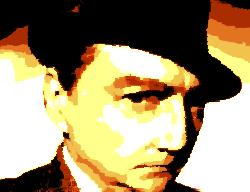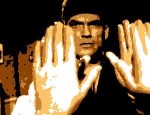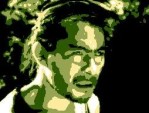Biography: life and films

Once he had established himself as an actor of some repute, Guitry began writing plays. His first success was Nono, written in 1905. Two years later, he married his father's young mistress Charlotte Lysès, creating a 13-year-long rift between father and son. The marriage lasted only 11 years. In 1919, Guitry married a second time, to the actress Yvonne Printemps, for whom he wrote several hugely successful musical comedies. In the course of his career, Sacha Guitry wrote 124 stage plays, many of which were adapted into films. In 1916, he launched the stage career of Raimu with Faisons un rêve.
During the silent era, Sacha Guitry had no great love of cinema. He regarded it as being vastly inferior to the theatre and was in no hurry to become a film director. He did however make one film around this time, Ceux de chez nous (1915), a documentary celebrating the work of various French artists (including Auguste Renoir and Anatole France). It was not until 1935 that Guitry deigned to direct and appear in a full-length film. This was Pasteur (1935), a biography of the French scientist Louis Pasteur, which was based on play of the same title that he had created for his father.
Sacha Guitry's second sound film, Bonne Chance, was more typical of the director's subsequent work - an exuberant comedy that showcased the talents of his third wife, Jacqueline Delubac, who would star in many of his later films. This was followed by Le Nouveau testament (1936) and Mon père avait raison (1936), after which Guitry made Le Roman d'un tricheur (1936), his first masterpiece and most influential film. In these and most of his other films (many based on his stage plays), Guitry took the lead role, something that fuelled his reputation as a monomaniac.
Les Perles de la couronne (1937) was the first in a series of lavish period pieces depicting scenes from French history. This was followed by Remontons les Champs-Elysees (1938), Si Versailles m'était conté (1954), Si Paris nous était conté (1956) and Napoléon (1955), an ambitious biography on the life of the Emperor Napoléon. In total, Guitry directed 30 full-length films, including 17 adaptations of his plays and a documentary which was made to accompany his controversial historical text De Jeanne d'Arc à Philippe Pétain.
The fact that Guitry remained very busy as an actor, writer and director during the Nazi occupation was seen by some as a sign that he supported the Vichy régime. In fact, much of the work that he produced during this period had a subtle anti-German slant - his film Le Destin fabuleux de Desirée Clary (1942), ostensibly about the life of Napoléon's fiancée, can be interpreted as a critique of Nazi Germany. Guitry never gave permission for his plays to be performed in Germany and on several occasions he used his influence to secure the release of fellow artists who had been arrested by the French and German police. All this was conveniently forgotten when, in August 1944, not long after the Liberation, Guitry was arrested by a group of resistance members and incarcerated for sixty days without charge. In the press Guitry was openly vilified by several writers although he was (three years after his arrest) cleared of the charge of collaboration.
His reputation tarnished, Guitry resumed his filmmaking career after the war, beginning with Le Comédien (1948), an affectionate biography of his father. The same year, he released Le Diable boiteux in which Guitry clearly identifies himself with the disgraced revolutionary Talleyrand (another misunderstood patriot). By the early 1950s, Guitry's health had begun to decline, aggravated by a rich diet and sedentary lifestyle. Too ill to direct Adhémar ou le jouet de la fatalité (1951), he handed over the directing duties to Fernandel, but was so shocked by the result that he took the actor to court, and lost. This humiliating defeat merely exacerbated Guitry's contempt for the legal system and ensured that his subsequent films would be much darker, much more cynical, than anything that had gone before.
This is most noticeable in La Poison (1951), a scurrilous black comedy in which Guitry attacks the failings of the French judicial system and the hypocrisy of French society in general. This allowed him to cast the film actor he most admired, Michel Simon, in what is easily one of his greatest roles. Far from being sated by this grotesque farce, Guitry's cynicism resulted in two more savage satires, La Vie d'un honnête homme (1953) and Assassins et voleurs (1957). Ill health prevented Guitry from completing his last film, Les Trois font la paire (1955) - bed-ridden, he had no choice but to hand over to Clément Duhour.
Throughout the last decade of his life, Sacha Guitry remained a controversial figure, an easy target for his detractors who, because of the collaboration slur, continued to portray him as a traitor to the French nation. As often as not, Guitry's films were ill-received by the critics, although, by the mid-1950s, his work was beginning to receive a fresh reappraisal. The most fervent admirers of Guitry's work were the reviewers on the staff of the review magazine Les Cahiers du cinéma. These included a young hothead, François Truffaut, who saw in Guitry the shining example of the auteur filmmaker.
Sacha Guitry died in Paris on 24th July 1957, aged 72. He is buried at Montmartre Cemetary in Paris, next to his father Lucien, his older brother Jean (who was killed in a car accident in 1920) and Lana Marconi, the last of his five wives. As film directors continue to adapt his work for cinema and television, and as theatrical productions of his plays still prove to be popular with audiences around the world, Sacha Guitry shows no sign of disappearing from our collective consciousness. Through his many film roles, he retains a very tangible presence and will doubtless continue to delight generations to come with his deliciously dry humour and mischievous mastery of the seventh art.
© James Travers 2013
The above content is owned by frenchfilms.org and must not be copied.
Filmography
Click here to view complete list of films...The very best fantasy films in French cinema

The best of Japanese cinema

The brighter side of Franz Kafka
